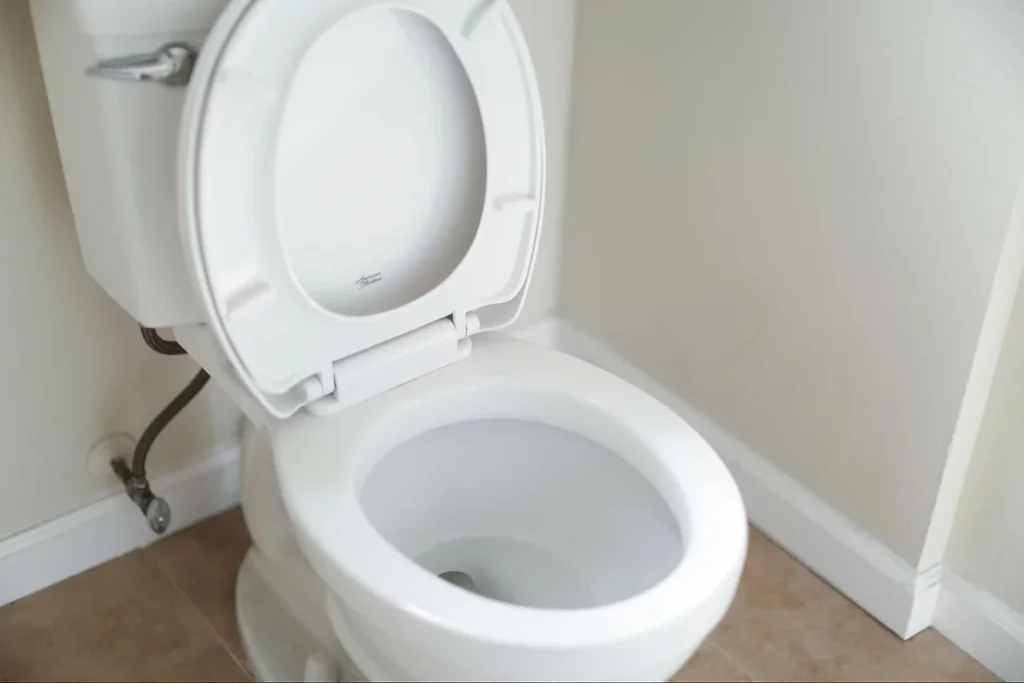Have you ever considered salting your toilet? It may sound strange, but there are surprising benefits to be gained from this simple and affordable practice.
In this blog post, we will explore the science behind salting your toilet and delve into the numerous advantages it brings.
By the end, you’ll be convinced to give it a try and enjoy a clean, fresh-smelling bathroom, free of clogs and odors. So, let’s dive in and discover why you should put salt in your toilet!
The Science Behind Salting Your Toilet
Before we delve into the benefits of salting your toilet, it’s essential to understand the science behind it. Salt, commonly known as sodium chloride (NaCl), has been used for centuries for its cleaning and purifying properties. When dissolved in water, it breaks down into positive sodium ions (Na+) and negative chloride ions (Cl-). These ions create an inhospitable environment for bacteria and other microorganisms, making salt an effective cleaning agent.
Benefits of Putting Salt in Your Toilet
3.1 Enhanced Cleaning Power
One of the primary benefits of putting salt in your toilet is its enhanced cleaning power. Salt’s natural abrasive properties make it excellent for scrubbing away stains and stubborn residue. It acts as a gentle exfoliant, leaving your toilet bowl sparkling clean without damaging the porcelain surface. Additionally, salt tackles hard water stains, rust, and mineral deposits, creating a pristine and sanitary environment in your bathroom.
3.2 Elimination of Odors
Nobody wants a smelly bathroom, and salting your toilet can help eliminate unpleasant odors. Salt’s antibacterial properties neutralize foul smells caused by bacteria and other microorganisms present in the toilet bowl. As salt breaks down, it releases chlorine, a powerful odor-neutralizer. This not only freshens up the air in your bathroom but also discourages the growth of odor-causing bacteria, keeping your toilet smelling clean and inviting.
3.3 Prevention of Mineral Build-up
Hard water can wreak havoc on your toilet, leaving behind unsightly mineral deposits. By adding salt to your toilet, you can prevent this build-up and prolong the lifespan of your plumbing. Salt helps break down the minerals present in hard water, preventing them from accumulating on the toilet bowl and internal mechanisms. Regular salting can save you from the hassle and expense of dealing with the consequences of mineral build-up in the long run.
3.4 Reduced Clogging
Clogged toilets can be a nightmare to deal with, causing inconvenience and potential plumbing issues. However, salting your toilet can help reduce the likelihood of clogs. Salt’s abrasive nature helps break down solid waste and toilet paper, preventing them from forming obstructions in the pipes. This natural and cost-effective method can save you from unnecessary frustration and expensive plumbing repairs.
3.5 Pest Control
Believe it or not, salting your toilet can also act as a pest control measure. Salt’s antimicrobial properties effectively deter pests like cockroaches and ants from infesting your bathroom. These critters dislike the chloride ions present in salt and will steer clear of the treated area. By keeping bugs at bay, salting your toilet creates a more sanitary and comfortable environment for you and your family.
How to Use Salt in Your Toilet
Now that you’re aware of the benefits, let’s explore different methods of using salt in your toilet.
4.1 Basic Salt Cleaning Method
The basic salt cleaning method is highly effective and requires minimal effort. Here’s how you can do it:
- Sprinkle a generous amount of salt around the inner rim of the toilet bowl.
- Let it sit for a few minutes to allow the salt to dissolve and start working.
- Using a toilet brush, scrub the bowl thoroughly, paying extra attention to stains and problem areas.
- Flush the toilet to rinse away the salt and reveal a clean, fresh-smelling bowl.
4.2 Salt and Vinegar Solution
For tougher stains and grime, combining salt with vinegar creates a powerful cleaning solution. Here’s what you need to do:
- In a spray bottle, mix equal parts of white vinegar and water.
- Spray the solution generously around the inside of the toilet bowl, making sure to cover all surfaces.
- Sprinkle salt onto the sprayed areas, allowing it to stick to the vinegar solution.
- Let the mixture sit for about 30 minutes to an hour, depending on the severity of the stains.
- Using a toilet brush, scrub the bowl thoroughly, ensuring you reach all the corners and under the rim.
- Flush the toilet to rinse away the solution, marveling at the sparkling clean bowl.
4.3 Salt and Baking Soda Combo
If you’re looking for a natural and eco-friendly cleaning option, salt can be combined with baking soda. Here’s a simple method to try:
- In a bowl, mix 1 cup of salt and 1 cup of baking soda.
- Sprinkle the mixture evenly around the inside of the toilet bowl, including the rim and under the edges.
- Using a toilet brush, scrub the bowl thoroughly, paying attention to areas with stains or mineral deposits.
- Let the mixture sit for at least 30 minutes to allow the combination of salt and baking soda to work its magic.
- Flush the toilet to rinse away the mixture, leaving behind a clean and fresh-smelling toilet bowl.
Myths and Misconceptions
While salting your toilet brings numerous benefits, there are a few common myths and misconceptions that need to be addressed.
5.1 Salt Damages Plumbing
Contrary to popular belief, salt does not damage plumbing systems when used in moderation. In fact, salt’s cleaning properties can help prevent mineral build-up and clogging, prolonging the life of your plumbing. However, it’s essential to avoid excessive salt usage, as it may corrode certain types of pipes over time. Moderation is key when it comes to reaping the benefits of salting your toilet without causing harm.
5.2 Salt Harms the Environment
Salt, when used appropriately, poses minimal harm to the environment. While excess salt can negatively impact vegetation and aquatic life, the amount used in toilet cleaning is relatively small and unlikely to cause significant harm. To further minimize environmental impact, choose eco-friendly salt options, such as rock salt or sea salt, as they are less processed and contain fewer additives.
5.3 Salt Attracts Bugs and Critters
Salt’s antimicrobial properties actually repel bugs and critters instead of attracting them. The chloride ions present in salt create an inhospitable environment for pests, making your bathroom less appealing to them. By salting your toilet, you’ll be deterring unwanted visitors and enjoying a bug-free bathroom.
Step-by-Step Guide to Salt Your Toilet
Now that you are convinced to give salting your toilet a try, follow this easy step-by-step guide to get started.
6.1 Step 1: Gather Your Supplies
To begin, gather the following supplies:
- Table salt, rock salt, or sea salt
- A toilet brush
- A spray bottle (for vinegar solution, if desired)
6.2 Step 2: Prepare the Salt Solution
Depending on the cleaning method you choose, prepare the salt solution accordingly. You can use plain salt or combine it with vinegar or baking soda, as discussed earlier.
6.3 Step 3: Apply the Salt Solution
Sprinkle the salt solution generously around the inside of the toilet bowl. Ensure that you cover all surfaces, including the rim, under the edges, and any stains or mineral deposits.
6.4 Step 4: Scrub and Flush
Using a toilet brush, scrub the bowl thoroughly, paying attention to problem areas. Scrub the rim, under the edges, and any visible stains or mineral deposits. Finish by flushing the toilet to rinse away the salt solution, revealing a clean and fresh toilet bowl.
Tips and Precautions
To make the most of salting your toilet and avoid any issues, keep the following tips and precautions in mind:
7.1 Use the Right Type of Salt
Choose a high-quality salt option like table salt, rock salt, or sea salt. Avoid using salt with additives like iodine or anti-caking agents, as they may stain or damage the toilet bowl.
7.2 Regular Maintenance is Key
While salting your toilet is beneficial, it should not replace regular cleaning and maintenance. Incorporate salting as part of your routine cleaning to keep your toilet in optimal condition.
7.3 Avoid Harsh Chemical Cleaners
To maintain a more natural and eco-friendly approach to toilet cleaning, avoid harsh chemical cleaners that may damage your plumbing. Using salt, along with vinegar or baking soda, can be just as effective without the harmful side effects.
Conclusion
In conclusion, salting your toilet is a simple yet effective practice that offers a multitude of benefits. From enhanced cleaning power and odor elimination to prevention of mineral build-up and reduced clogging, the advantages are clear. By following the step-by-step guide and incorporating regular salting into your bathroom maintenance routine, you can enjoy a sparkling clean toilet that is fresh-smelling and free from pesky pests. So, why wait? Go ahead and give salting your toilet a try – you’ll be amazed by the difference it makes!

